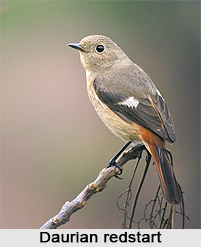 Daurian Redstart is an Indian Bird that bears a scientific name of "Phoenicurus auroreus" widespread in temperate Asia.
Daurian Redstart is an Indian Bird that bears a scientific name of "Phoenicurus auroreus" widespread in temperate Asia.
Category of Daurian Redstart
Daurian redstart is a small passerine bird from temperate Asia. In Japan, it is known as jobitaki.
Behaviours of Daurian Redstart
Daurian Redstarts are strongly sexually dimorphic. The breeding male Daurian redstart have a grey crown and nape with lighter forehead and crown-sides, a black face and chin, brownish mantle and wings and a large white wing patch; the chest, lower back and rump are orange, and the tail is black with orange sides. Juvenile males are similarly patterned but much duller and less clearly marked. The female Daurian redstart are warm brown above, paler below, have an orange rump and tail sides, and have a large white wing patch similar to the males. The bill, eye, legs and feet of Daurian redstart are black in both sexes.
Family of Daurian Redstart
Daurian Redstart belongs to a close-knit Eurasian clade which also includes the black redstart (P. ochruros), Hodgson`s redstart (P. hodgsoni), the white-winged redstart (P. erythrogastrus) - which may be especially closely related to P. auroreus -, and maybe the Ala Shan redstart (P. alaschanicus). These all diverged during the latter part of the Late Pliocene and the earliest Early Pleistocene, some 3-1.5 million years ago, during onset of the Quaternary glaciations.
Migration of Daurian Redstart
Daurian Redstart is a fairly common bird in East Asia, ranging eastwards from Mongolia and the Himalayas. It is migratory; P. A. Auroreus winters in Korea, Japan, southeast coastal China and Taiwan, and P. A. Leucopterus in northern India and parts of Southeast Asia.
Habitat of Daurian Redstart
Daurian Redstarts favour open forests, forest edges, agricultural margins, and are also commonly found in parks and urban gardens. They are reasonably confiding and often allow humans to approach quite closely before moving off.
Breeding of Daurian Redstart
Daurian Redstart breeds in the summer months, with a mated pair of the nominate subspecies having been encountered in early May.











